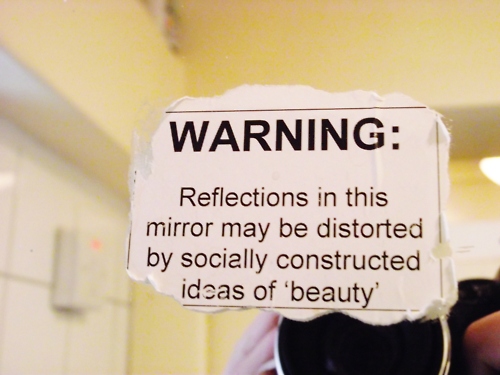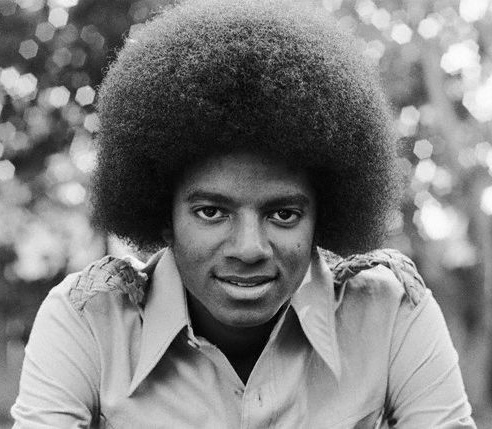
 When you look in the mirror, what do you see? Obviously, no one is able to see what they really look like, because only flat mirrors will produce a true reflection, and due to even the slightest manufacturing errors, household mirrors are never perfectly flat. However, the reflection that is reciprocated when you look in the mirror is extremely close to how everyone else sees you. Even so, some people perceive their reflections in a mirror from minute to far fetched exaggerations of how their reflections appear. People who deal with anorexia or bulimia fall on the extreme and "far fetched" side of this spectrum, but on the opposite end of the spectrum, there are people who are consumed with the thoughts of an imperfect appearance. Where does this insecurity come from? There is no evidence that people are somehow born with insecurities of their appearance or behavior, so what continues to perpetuate this "condition" in today's society? For one, the media plays a monumental role in declaring what is perceived as "beautiful" and what is not through photoshopped photos of supermodels gracing magazine covers, and the idolization of handsome or beautiful actors and actresses who appear to have it all. As a result, many people end up altering their identities and personalities to fit society's standards.
When you look in the mirror, what do you see? Obviously, no one is able to see what they really look like, because only flat mirrors will produce a true reflection, and due to even the slightest manufacturing errors, household mirrors are never perfectly flat. However, the reflection that is reciprocated when you look in the mirror is extremely close to how everyone else sees you. Even so, some people perceive their reflections in a mirror from minute to far fetched exaggerations of how their reflections appear. People who deal with anorexia or bulimia fall on the extreme and "far fetched" side of this spectrum, but on the opposite end of the spectrum, there are people who are consumed with the thoughts of an imperfect appearance. Where does this insecurity come from? There is no evidence that people are somehow born with insecurities of their appearance or behavior, so what continues to perpetuate this "condition" in today's society? For one, the media plays a monumental role in declaring what is perceived as "beautiful" and what is not through photoshopped photos of supermodels gracing magazine covers, and the idolization of handsome or beautiful actors and actresses who appear to have it all. As a result, many people end up altering their identities and personalities to fit society's standards. |
| Barbie Dolls: Is this how we define beauty? |
 |
| Michael Jackson in 2005 |
 |
| Michael Jackson circa 1970s |
In receiving the stereotypical gift of a "big, blue-eyed, Baby Doll" for Christmas, Claudia MacTeer begins to question the legitimacy of society's social construct of perfection and beauty.
I had only one desire: to dismember it. To see of what it was made, to discover the dearness, to find the beauty, the desirability that had escaped me, but apparently only me. Adults, older girls, shops, magazines, newspapers, window signs-- all the world had agreed that a blue-eyed, yellow-haired, pink-skinned doll was what every girl child treasured (20).Like the adolescents of today's society, Claudia's family is affected by the perpetuation of society's standards of beauty. They bought Claudia the baby doll because they were enchanted by the idea that this baby doll represented a way for Claudia to fit in to society's definitive standards. However, Claudia's "inferiority complex" forced her to investigate the origins of the standard of perfection manifested through the doll. She claims the "desirability had escaped her" illustrating a consciousness of her worthlessness according to society's standards, and acknowledges the influence of the "shops, magazines, newspapers, and window signs" in formulating society's definition of beauty. However, as soon as she dismembers the doll, she discovers the fake, manufactured facade of this baby doll demonstrated through "a mere metal roundness", or the battery, that keeps the doll functioning (21). When Claudia looks in the "mirror" she sees a girl that refuses to believe the socially constructed ideas of beauty, but she also sees that any attempt to counter this stereotype would be futile because of her race. She is left with conflicted feelings and a state of mind that refuses to let her believe she is worth anything.
Contrarily, Geraldine deals with her "inferiority complex" in the opposite way. Geraldine conforms to the standards set by society because she is attempting to overcome her "inferiority complex" through compensating for it in the only way she knows how: bourgeois respectability. Geraldine's attempts are illustrated in Morrison's words characterizing Geraldine's lifestyle.
Here they learn the rest of the lesson...how to behave. the careful development of thrift, patience, high morals, and good manners. In short, how to get rid of the funkiness (83).Geraldine longing to get rid of the so-called "funkiness" that represents her rich African American heritage, parallels the skepticism that surrounds the reasons for Michael Jackson's nose job and drastic skin color transformation. Geraldine's "racial self-loathing" consumes her, and she longs to conform to American society's definitions of beauty and what is acceptable in order to eradicate the "inferiority complex" from her life. However, despite her various attempts, she is unable to measure up to the unattainable standards of perfection and is left broken when she ends up "in the second row, her white blouse starched, and blue skirt almost purple from ironing" (82).
No comments:
Post a Comment